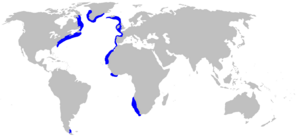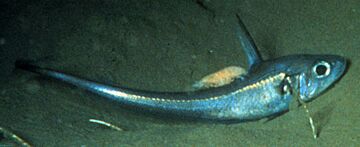Black dogfish facts for kids
Quick facts for kids Black dogfish |
|
|---|---|
 |
|
| Conservation status | |
| Scientific classification | |
| Genus: |
Centroscyllium
|
| Species: |
fabricii
|
 |
|
| Range of the black dogfish | |
| Synonyms | |
|
Spinax fabricii Reinhardt, 1825 |
|
The black dogfish (Centroscyllium fabricii) is a type of shark. It belongs to the family called Etmopteridae. These sharks are often found deep in the ocean. They live over the outer continental shelf and continental slope. This means they are found where the land drops off into the deep sea. They live at depths from 180–2,250 m (590–7,380 ft).
Female black dogfish usually live in deeper water than males. Also, smaller sharks might live at different depths than larger ones. This shark lives in many parts of the Atlantic Ocean. You can find them from Greenland and Iceland down to Virginia and West Africa. They also live off southwestern Africa and Argentina. The black dogfish is the biggest shark in its family. It usually grows to be 60–75 cm (24–30 in) long. It has a strong, dark brown body. Its belly is darker than its back. It also has tiny lights on its skin that glow in the dark! These are called bioluminescent organs. It has two dorsal fins (fins on its back) with strong spines in front of them. It does not have an anal fin (a fin on its underside near the tail).
Black dogfish are active sharks and often swim in groups. They are predators and scavengers. This means they hunt other animals and also eat dead ones. They mostly eat bony fishes, crustaceans (like crabs and shrimp), and cephalopods (like squid). Black dogfish give birth to live young. Females can have four to 40 pups at a time. The pups grow inside the mother and get food from a yolk sac. There is no special time of year for them to have babies. Mating and birth happen all year round.
This shark is often caught by accident in deep-sea commercial fisheries in the North Atlantic. It is not worth much money, so it is usually thrown back into the sea. Many parts of its home range do not have much deep-sea fishing. Also, the number of black dogfish in the northwestern Atlantic seems steady. Because of this, the International Union for Conservation of Nature (IUCN) says this species is of Least Concern overall. However, in the northeastern Atlantic, it is listed as Near Threatened. This is because heavy fishing might have caused their numbers to drop there.
Contents
Discovering the Black Dogfish
The first black dogfish ever studied was found near Julianehåb in Greenland. A Danish zoologist named Johannes Reinhardt described it in 1825. He named it Spinax fabricii. He did this to honor Otto Fabricius. Otto Fabricius was a missionary and naturalist who studied fish in Greenland.
Later, in 1839–41, two German biologists, Johannes Müller and Jakob Henle, created a new group (genus) for this shark. They called it Centroscyllium.
Scientists are still studying the black dogfish. They want to confirm if the black dogfish in the North Atlantic and the southeastern Atlantic are the exact same species. A study in 2010 looked at the shark's DNA. It found that the black dogfish is closely related to the whitefin dogfish.
Where Do Black Dogfish Live?
The black dogfish is a common shark. It lives in many places in the temperate waters of the Atlantic Ocean. It does not go into the very cold Arctic Ocean. In the northeast Atlantic, you can find it from Iceland to Sierra Leone. This includes places like the Faroe Islands and southern Norway. In the northwest Atlantic, it lives from southern Greenland to Virginia. It is very common in the Laurentian Channel. It might even be found further south in the Gulf of Mexico. In the southeast, it lives off Namibia and South Africa. In the southwest, it has been seen near Argentina.
These sharks live mostly near the bottom of the ocean. They are found at depths from 180–2,250 m (590–7,380 ft). They are most common at certain depths depending on the area. For example, off Iceland, they are often found at 800–1,200 m (2,600–3,900 ft). Off Greenland, they are common at 500–1,300 m (1,600–4,300 ft).
Sometimes, these sharks might swim closer to the surface. This happens especially in the northern parts of their range during the dark, cold winter. In the North Atlantic, female sharks often live deeper than males. Females are more common at depths greater than 1 km (0.62 mi).
Black dogfish like water temperatures around 3.5–4.5 °C (38.3–40.1 °F). But off northern Canada, they prefer slightly warmer water, around 5–6.5 °C (41.0–43.7 °F). They can even handle temperatures as low as 1 °C (34 °F). There is some evidence that these sharks move around with the seasons. They might spend winter and spring in shallower water.
What Does a Black Dogfish Look Like?
Adult black dogfish are usually 60–75 cm (24–30 in) long. They can grow up to 1.1 m (3.6 ft). This makes them the largest shark in their family! Females tend to grow bigger than males.
This shark has a strong body that is a bit flattened from side to side. Its snout (nose) is quite long, thick, and flat. It forms a wide curve at the front. The shark has large, oval eyes that look green and shiny. They do not have special protective eyelids. Behind the eyes are much smaller holes called spiracles. These help the shark breathe.
The mouth is wide and curved. It has thin lips and short, deep grooves at the corners. There are about 34 rows of teeth on each side of both jaws. Each tooth has three (sometimes up to five) thin points. The middle point is the longest.
The black dogfish has two dorsal fins (on its back). Strong, grooved spines are right in front of each fin. The second dorsal fin is much longer than the first. The first dorsal fin is small and rounded. It starts behind the pectoral fins (fins on its sides). The second dorsal fin is more angled and about twice the size of the first.
The pectoral fins are small and rounded. The pelvic fins (fins on its underside) are about as big as the second dorsal fin. The tail area is short and leads to a wide caudal fin (tail fin). The tail fin is less than a quarter of the shark's total length.
The shark's skin is covered in tiny, thorn-like dermal denticles. These are like tiny teeth on its skin. The shark is plain dark brown on top. It gets almost black underneath. Its dorsal fin spines are white. Young sharks have white edges on their dorsal, pectoral, and pelvic fins. Tiny, glowing dots are scattered all over its skin. These dots make the shark glow in the dark!
How Black Dogfish Live
Black dogfish often swim in groups. These groups tend to be larger in winter and spring. Even though they are active, they are not built for super-fast bursts of speed. Their lipid-filled liver helps them stay afloat in the water. It makes up about one-fifth of their total weight.
Bigger sharks and bony fish might hunt black dogfish. This shark can also get parasites. One type of barnacle called Anelasma squalicola can attach to it. This barnacle can stop the shark from reproducing properly. Other parasites include flukes, copepods, and protozoans.
The black dogfish eats whatever it can find. It hunts in the open water and also eats dead animals from the ocean floor. Most of its diet is made up of different kinds of bony fishes. These include rattails, whitings, rockfishes, and lanternfishes. They also eat pelagic crustaceans like krill and shrimp, and cephalopods like squid. As the shark gets older, fish become a more important food source. Crustaceans become less important. Sometimes, they even eat polychaete worms and jellyfish. In the northwestern Atlantic, black dogfish often eat fish scraps. These scraps come from fishing boats. This is especially true for older sharks that can eat bigger pieces of fish.
Life Cycle of the Black Dogfish
Black dogfish reproduce all year round. There is no specific breeding season. These sharks give birth to live young. The baby sharks grow inside the mother's uterus. They get all their food from a yolk sac. Female sharks have two working ovaries and two working uteruses.
When eggs are ready, they move into the uterus. They are about 3.0–4.5 cm (1.2–1.8 in) wide. The eggs are not inside a hard shell. The external yolk sac is fully used up when the baby shark is almost ready to be born. The rest of the yolk goes into an internal yolk sac. This internal yolk sac helps feed the newborn shark until it learns to hunt on its own. A female can have anywhere from four to 40 pups at a time. Newborns are about 13–19 cm (5.1–7.5 in) long.
The size at which black dogfish become mature varies. Males are usually ready to reproduce when they are between 46 and 63 cm (18 and 25 in) long. Females are ready when they are between 51 and 70 cm (20 and 28 in) long. This depends on where they live. Off northern Canada, females give birth in shallower parts of the Laurentian Channel. As the young sharks grow, they move into deeper parts of the Channel. Then they travel long distances north to the deep continental slope.
Black Dogfish and Humans
The black dogfish is not harmful to humans. It is also not very valuable for fishing. However, many black dogfish are caught by accident. This happens when commercial deep-sea boats use trawl nets, gillnets, and longlines. These fisheries operate all over the North Atlantic. This includes fishing for Greenland halibut off Iceland and various fish off Canada.
When caught, these sharks are usually thrown back into the sea. But recently, more small deepwater sharks are being kept. They are used to make fishmeal. The amount of black dogfish caught by European countries has gone down. For example, France caught 486 tons in 2001, but only 35 tons in 2006. Canadian fisheries caught about 68 tons per year from 1996 to 2005. Off southern Africa, the black dogfish usually lives too deep for fishing boats to reach.
The International Union for Conservation of Nature (IUCN) has listed the black dogfish as Least Concern worldwide. This means it is not currently at high risk of disappearing. Fishing does not affect it much in many areas. Also, its population in the northwestern Atlantic seems stable. It might even have grown from 1978 to 1995.
However, in the northeastern Atlantic, there is a lot of deepwater fishing. Because of this, the IUCN has listed the black dogfish there as Near Threatened. This means it could become threatened in the future. Black dogfish grow to be large before they can reproduce. This might make them sensitive to overfishing. But they also have more babies than some other deep-sea dogfish sharks. In the northeastern Atlantic, rules are in place to manage how many deep-sea sharks can be caught.





